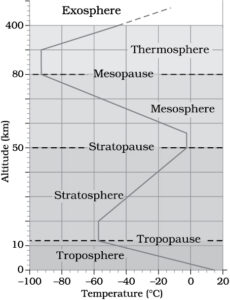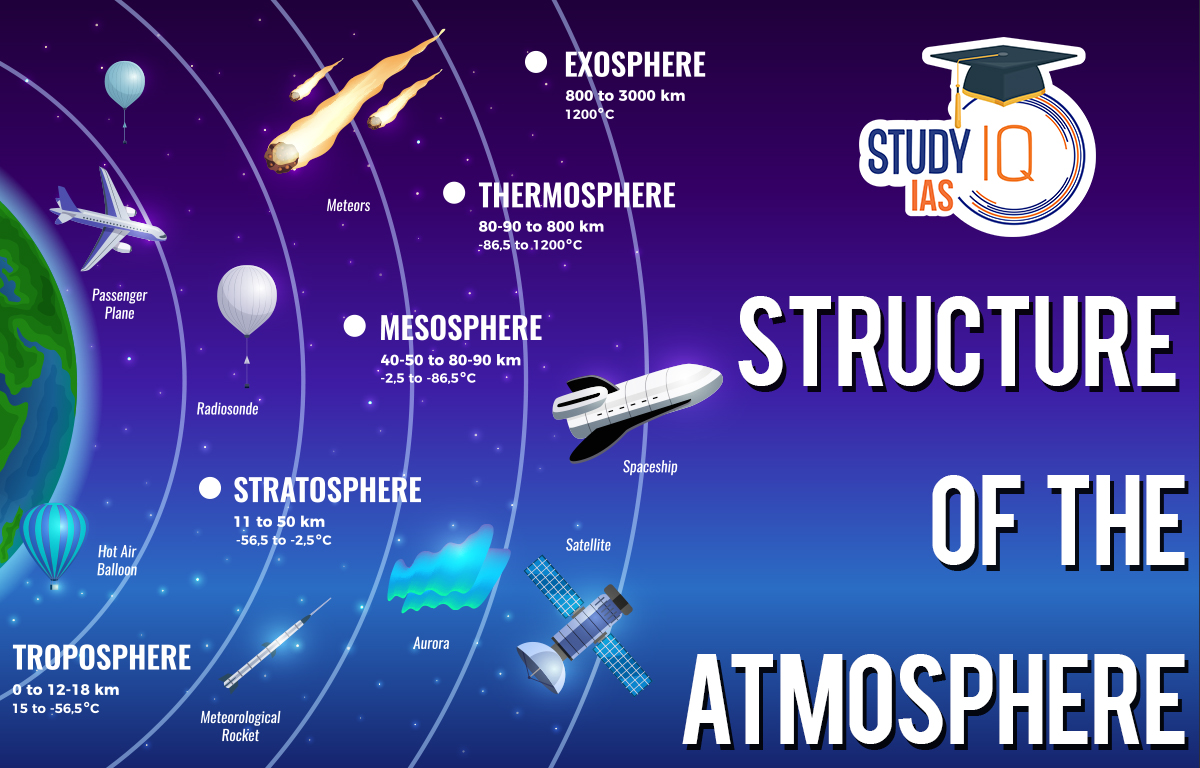Table of Contents
Structure of the Atmosphere
The atmosphere is the air surrounding our planet consisting of layers of gases that are essential for life like oxygen for humans and carbon dioxide for plants. These layers are held by gravity, it protects us from harmful UV rays and maintains a suitable temperature for living things. While it extends up to about 1600 kilometers above Earth, 99 percent of its mass is within just 32 kilometers from the surface.
The atmosphere is structured in distinct layers, each with unique properties, such as temperature and composition. You can think of it like a multi-layered cake, where each layer serves a specific function. Earth’s atmosphere consists of five main layers: the troposphere, stratosphere, mesosphere, thermosphere, and exosphere. Each layer varies in its composition, temperature, and altitude. Let us take a closer look at these layers along with a diagram.
Read about: Climate of India
Composition of the Atmosphere
Earth’s atmosphere is made up of about 78% nitrogen, 21% oxygen, and 1% other gases. Nitrogen (N2) is the most abundant gas and is essential for the survival of all living organisms. Oxygen (O2) is vital for humans and animals, who breathe it in, while green plants produce it during photosynthesis, helping to keep oxygen levels stable. Carbon dioxide (CO2) is another important gas it acts as a greenhouse gas, primarily coming from the burning of fossil fuels. These gases are distributed in atmospheric layers, each characterized by different temperature and pressure conditions.
Carbon Dioxide
- Carbon dioxide is very important in meteorology.
- It is transparent to incoming sunlight but blocks some of the Earth’s emitted radiation.
- It reflects some of this radiation back to Earth’s surface.
- Carbon dioxide is a major cause of the greenhouse effect.
- Its levels have been rising due to the burning of fossil fuels. This increase in carbon dioxide is the main cause of global warming.
- Carbon dioxide is a colorless and odorless gas. It is soluble in water, ethanol, acetone and has the following properties:
- Melting Point: -55.6 deg
- Boiling Point: -78.5 Degree
- Density: 1.977
Ozone Gas
- Ozone is an important part of the atmosphere, contains high concentrations of Ozone(O3)
- Ozone is a very reactive gas and attacks other molecules in the air, often regenerating oxygen in the process
- It is mostly found 10 to 50 kilometers above Earth’s surface.
- Bluish Gas that harmful to breathe
- Ozone acts like a shield, absorbing the Sun’s harmful ultraviolet (UV) rays and preventing them from reaching the ground.
- The small amount of ozone in the atmosphere is in the stratosphere’s ozone layer.
- Although it represent only a tiny fraction of the atmosphere, Ozone is essential for life on Earth
Water Vapour
- Water vapor is the gas form of water in the atmosphere.
- Responsible for all types of precipitation.
- Less water vapor at higher altitudes, decreases from the poles to the equator.
- Can make up to 4% of the atmosphere in warm, humid areas.
- Enters the air mainly through evaporation from oceans, rivers, lakes, and transpiration from plants.
- Water vapor is the most common greenhouse gas on Earth.
- Accounts for about half of the greenhouse effect, trapping the Sun’s heat in the atmosphere.
- Greenhouse gases keep Earth warm enough for life; without them, Earth would be about 59°F (33°C) colder.
- Important part of the water cycle, changing between liquid, ice, and gas as it moves through the air, land, and oceans.
Layered Structure of the Atmosphere
Depending upon temperature there are five layers in the Structure of the atmosphere. These are:
- Troposphere
- Stratosphere
- Mesosphere
- Thermosphere
- Exosphere

Troposphere
| Troposphere |
|
Stratosphere
| Stratosphere |
|
Mesosphere
| Mesosphere |
|
Thermosphere
| Thermosphere |
|
Ionosphere
| Ionosphere |
|
Exosphere
| Exosphere |
|
Structure of the Atmosphere UPSC Facts
- From lowest to highest, the major layers are the troposphere, stratosphere, mesosphere, thermosphere and exosphere.
- About 78% of the gases in the Earth’s atmosphere are nitrogen, 21% are oxygen, 0.9 % are argon, and 0.1 % are other gases.
- The remaining 0.1 per cent of gases includes trace amounts of neon, water vapour, methane, carbon dioxide, and methane.
- The thermosphere is the hottest layer.
Other Indian Geography Topics
Other Fundamental Geography Topics


 Story of Meera Bai and Her Devotion For ...
Story of Meera Bai and Her Devotion For ...
 Desert Climate, Distribution, Climatic C...
Desert Climate, Distribution, Climatic C...
 Deserts of India Map, Features of Thar D...
Deserts of India Map, Features of Thar D...





















